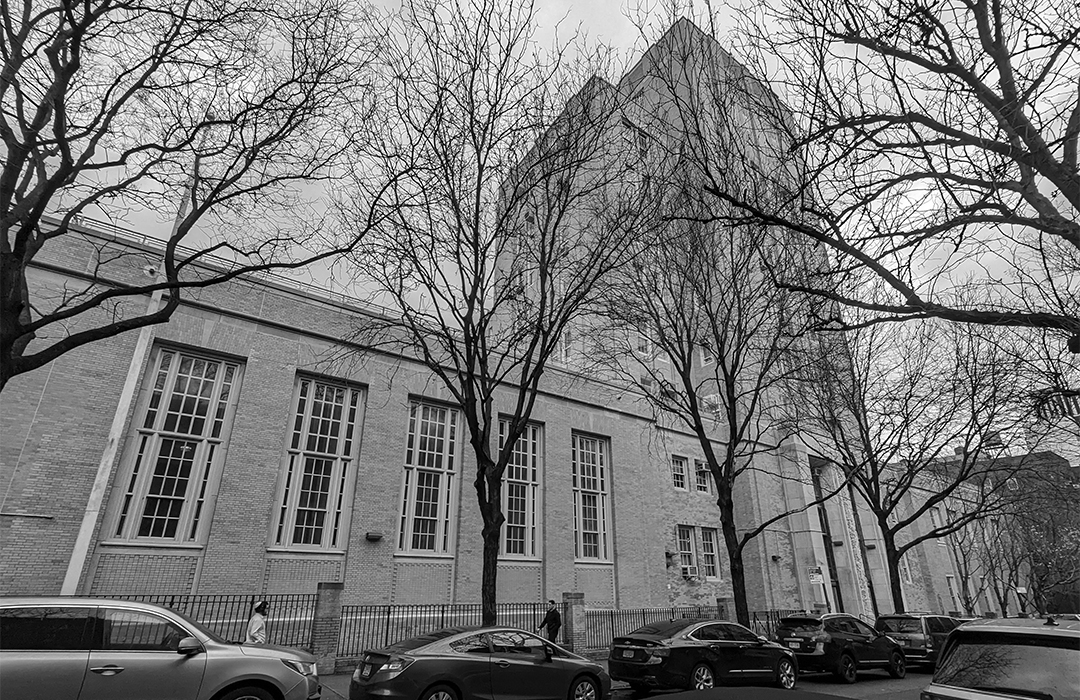
Joan of Arc Junior High School
by Tom Miller
In 1941, Joan of Arc Junior High School on West 93rd Street between Columbus and Amsterdam Avenues opened its doors. Designed by architect Eric Kebbon, its eight-story central portion was flanked by two-story wings. One held the gymnasium and the other the auditorium. At a time when Art Moderne, or Streamline Moderne, architecture stressed curving limes, rounded corners, and an absence of ornamentation, Kebbon had chosen the Art Deco style of a generation earlier. It was most noticeable in the double-height entrance, the central pier of which was decorated with a striking, carved Art Deco vine that dripped grapes, flowers, and mythological motifs—a sword, a crown, and a sheep, for instance.
Joan of Arc Junior High School was progressive and innovative from its inception. A touching incident occurred in the auditorium during graduation on June 26, 1944. Four years earlier, in August 1940, and before she could begin classes in the school, Laura Machen was stricken with poliomyelitis. The bright young girl previously had a beautiful singing voice and hopes of a career on stage. Now, it seemed, her future was bleak. She lost her voice and could no longer use her legs or hands. Even still, teachers gave her individual instruction at her bedside. Since she could no longer hold a pen or write, her tests were given orally. She slowly regained her throat muscles by singing to records, and then in November 1943, she was provided with a voice teacher.
Laura Machen passed her final examinations with a score of 93. On that graduation day in 1944, she accepted her diploma from her wheelchair and then sang in “a fine soprano voice,” according to The New York Times, Dvorak’s “Songs My Mother Taught Me” and “Oh, What a Beautiful Morning” from the Broadway hit Oklahoma. Laura told a reporter that now she hoped to become a radio singer.
On June 8, 1947, the auditorium was the scene of a reception for 200 refugees. It was part of an appeal for volunteers to teach English as a second language in free classes. Hazel R. Clark, the executive secretary of The Committee for Refugee Education, Inc., explained, “We try to teach refugees between 21 and 60 enough English to enable them to get along in everyday life and earn a living.”
Joan of Arc Junior High School was progressive and innovative from its inception.
A surprising use of the auditorium came on September 30, 1948, when Opera ’48 opened. The small company kicked off the season with Eugen D’Albert’s Tiefland. Two years later and now called the Joan of Arc Playhouse, the auditorium was the venue for productions like the Jewish Education Committee Theatre for Children’s Rich Man, Poor Man on February 12, 1950.
Change was coming to the neighborhood at the time. In Manhattan at Mid-Century, An Oral History compiled by Myrna Kat Frommer and Harvey Frommer, former student Jane Bevans recounts:
Joan of Arc was a very integrated junior high school and a very rough place, like something out of West Side Story. There were kids who didn’t speak English. The boys seemed much older and much more sexual than us. They dressed in black pants and white shirts and carried knives in their socks. There was a lot of pushing. You stayed out of the way. You went to and from school with your friends, traveled in packs.
Even instructors learned to “stay out of the way.” In June 1955, 28-year-old teacher James O’Farrell was stabbed in class by a student. It was enough to prompt O’Farrell to give up his work at Joan of Arc and transfer to a school in the Bronx.
Despite the sketchy environment, Joan of Arc Junior High produced some illustrious graduates. Among them was Winston E. Allen. He lived in Harlem, but his mother got into the school by using the address of one of her friends who lived in the district. He would go on to start his own business, Creative Investor Services, Inc., in 1962; earn a Ph.D. from Fordham University, and serve on the board of the United States Committee for UNICEF. He is, as well, the founder and president of the Winston E. Allen Foundation, Inc., which provides support to low-income, minority, and under-represented students in college or as start-up business owners.
Saul Zabar graduated from John of Arc Junior High in 1946. He would go on to become president of Zabar’s, perhaps the most well-known of Manhattan’s upscale food stores. A year after Zabar’s graduation, Ruth L. Weiss Hohberg first walked in the doors of the school. Born in Krakow, Poland, she had escaped the Nazis with her family only a few years earlier. Although she spoke no English, she persevered and became a prolific author.
Another stabbing that took place in the school was that of Michael Meltsner. In his 2006 autobiography, The Making of a Civil Rights Lawyer, he writes, “The distraught Puerto Rican classmate who out of the blue had stabbed me with the business end of a smoldering soldering iron in shop class at John of Arc Junior High School was Hispanic, all right, but only in the descriptive sense; to me, José was just another out-of-control hazard of city live, not an ethnic imperative.” Michael Metsner became a Professor of Law at Northwestern University. Hired by Thurgood Marshall, he was the first assistant counsel to the NAACP Legal Defense Fund.
Two other outstanding graduates were Robert Stephen “Bob” Leaf, and Rhina P. Espaillat. Leaf became the creator of Burson-Marsteller’s network of worldwide offices which made it the world’s largest public relations firm during the 1980s. Rhina Espaillat, who was born in the Dominican Republic and whose family was exiled to the United States by the dictatorial Trujillo regime, is an award-winning poet.
Novelist, playwright, and songwriter Ira Levin attended Joan of Arc Junior High. Among his novels are The Stepford Wives, The Boys from Brazil, and Rosemary’s Baby. Like those works, his play Deathtrap was adapted into a movie.
Clifford Irving attended Joan of Arc before enrolling in the High School of Music and Art. Like Levin, he pursued a writing career, publishing nearly two dozen novels before his death in 2017.
Novelist, playwright, and songwriter Ira Levin attended Joan of Arc Junior High. Among his novels are The Stepford Wives, The Boys from Brazil, and Rosemary’s Baby.
The 1970s were a period of severe upheaval within Joan of Arc Junior High. The principal in 1970 was Lula Bramwell until her termination on December 2. She was reassigned to an administrative position at the Board of Education. Bramwell insisted “the effort to oust her was begun because she is black.” (On December 22, The New York Times noted, “Most of the 1,300 pupils in the school are black or of Spanish-speaking background.”) Although an interim principal was assigned to Joan of Arc, Bramwell refused to budge, returning to her office day after day. “I am here essentially so that the children do not riot,” she said. The stand-off lasted until May 1972, when the Board of Education overruled the School Chancellor and reinstated Lula Bramwell as principal with back pay.
Things had deteriorated to the point of danger by then. On December 2, 1971, a 12-year-old female student leaving school was “struck on the head by a filing cabinet that was dropped from the sixth floor,” as reported by The New York Times. She was taken to St. Luke’s Hospital in serious condition. And on the morning of March 22, 1974, three intruders walked into the school brandishing a loaded revolver. It went off, wounding a 14-year-old student in the abdomen.
The following decade saw marked improvement. Although few students at Joan of Arc Junior High School could afford home computers, the Computer Room here became a favorite spot. And, in 1984, the auditorium once again became an operatic venue, home to the Bel Canto Opera Company. It would produce operas here for several years.
In the first years of the 21st century, 154 West 93rd Street became PS 333, Manhattan School for Children. In 2021, there was another push to oust a principal, this time Claire Lowenstine. Once again, race was an issue. On November 20, The New York Post reported, “Among various complaints, the survey alleges that Lowenstein has hired too many white teachers and not enough faculty of color.”
Today, the former Joan of Arc Junior High School is shared by the Manhattan School for Children, the Community Action School, and the Lafayette Academy. It is a greatly overlooked Art Deco structure that has produced more than its fair share of esteemed graduates.
Tom Miller is a social historian and blogger at daytoninmanhattan.blogspot.com





